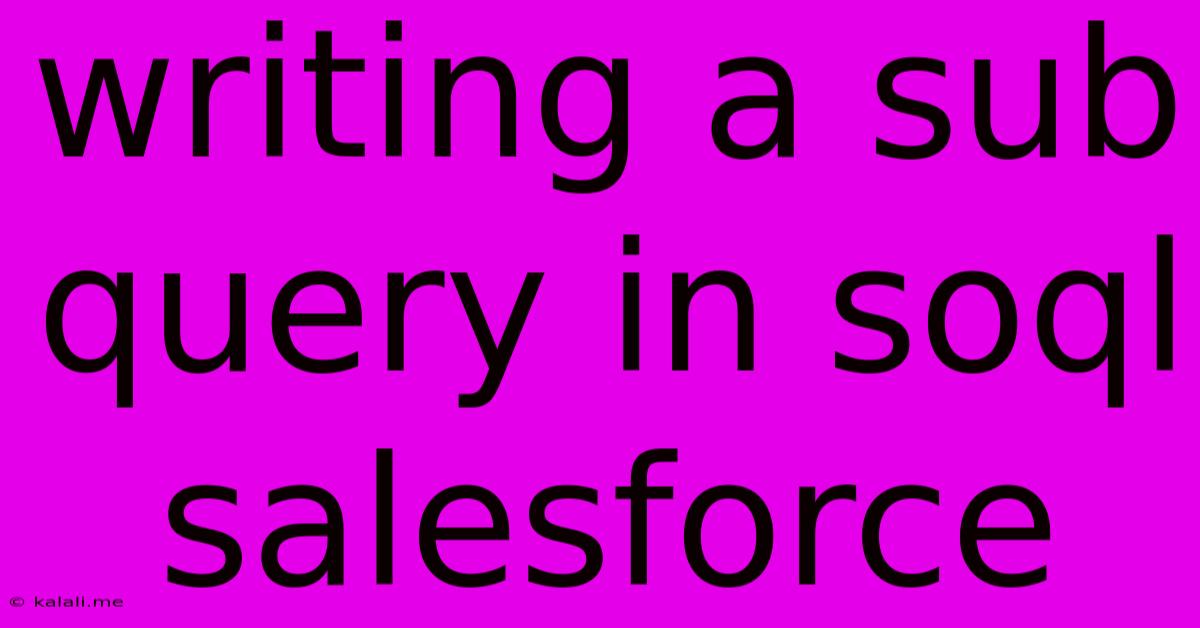Writing A Sub Query In Soql Salesforce
Kalali
Jun 03, 2025 · 3 min read

Table of Contents
Mastering Subqueries in SOQL: A Comprehensive Guide for Salesforce Developers
This article provides a comprehensive guide to writing subqueries in SOQL (Salesforce Object Query Language), a crucial skill for any Salesforce developer seeking to efficiently retrieve complex data relationships. Understanding subqueries allows you to build more sophisticated queries, retrieving data from multiple related objects in a single query, improving performance and reducing the number of queries needed. We'll cover the basics, best practices, and common pitfalls to avoid.
What are SOQL Subqueries?
SOQL subqueries allow you to embed a SELECT statement within another SOQL query. This enables you to retrieve data from related objects based on criteria defined in the main query. Think of it as a nested query, where the inner query (subquery) provides data that filters or enhances the results of the outer query. This is particularly useful when dealing with master-detail relationships, like Accounts and Contacts, or Opportunities and Opportunity Line Items. Instead of making multiple SOQL calls, a subquery neatly encapsulates the related data retrieval within a single query.
Syntax and Structure:
The fundamental structure of a SOQL subquery involves nesting a SELECT statement within the IN or EXISTS clause of the main query.
INClause: This clause retrieves records from the parent object where a field matches any value returned by the subquery.
SELECT Id, Name, (SELECT Id, Name FROM Contacts) FROM Account WHERE Id IN (SELECT AccountId FROM Opportunity WHERE StageName = 'Closed Won')
This query selects Accounts and their related Contacts, but only for Accounts associated with Closed Won Opportunities. The subquery (SELECT AccountId FROM Opportunity WHERE StageName = 'Closed Won') identifies the relevant Account Ids.
EXISTSClause: This clause checks for the existence of records in the related object matching the criteria in the subquery. It's more efficient thanINwhen you only need to know if related records exist, not the actual records themselves.
SELECT Id, Name FROM Account WHERE EXISTS (SELECT Id FROM Contacts WHERE AccountId = Account.Id AND Email LIKE '%@example.com%')
This query selects Accounts that have at least one Contact with an email address containing "@example.com". The subquery checks for the existence of such Contacts; it doesn't retrieve the Contact details.
Best Practices and Considerations:
- Keep it concise: Avoid overly complex subqueries, as they can impact performance. Break down complex data retrieval into multiple, simpler queries if necessary.
- Limit subquery depth: Nesting multiple levels of subqueries can severely degrade performance. Aim for a single level of nesting whenever possible.
- Use
EXISTSwhen appropriate: TheEXISTSclause is generally more efficient thanINwhen you only need to check for the existence of related records. - Optimize for governor limits: Be mindful of SOQL governor limits, particularly the number of SOQL queries allowed within a transaction. Subqueries contribute to this limit.
- Understand the relationship between objects: Accurate understanding of the object relationships is essential for writing efficient and correct subqueries. Incorrectly referencing fields will result in errors.
Common Errors and Troubleshooting:
- Non-selective subqueries: Subqueries that return a large number of records can significantly impact performance. Ensure your subquery criteria are sufficiently selective.
- Incorrect object relationships: Double-check your object relationships and field names to ensure they accurately reflect the data model.
- Governor limit exceptions: If your query exceeds governor limits, consider optimizing your query, or breaking it into multiple smaller queries.
Conclusion:
Mastering SOQL subqueries is vital for building efficient and powerful Salesforce applications. By understanding their syntax, best practices, and potential pitfalls, you can significantly improve the performance and scalability of your code. Remember to prioritize efficient query design and always be mindful of governor limits to avoid unexpected errors. Using subqueries effectively allows you to retrieve complex data relationships elegantly and efficiently, streamlining your Salesforce development process.
Latest Posts
Latest Posts
-
How To Tell If Your Fish Is Pregnant
Jun 05, 2025
-
Where To Use Caliper Grease During Brake Job
Jun 05, 2025
-
Did God Abandon Jesus On The Cross
Jun 05, 2025
-
Environment Location Directory Is Not Empty
Jun 05, 2025
-
How Do I Feed As A Vampire In Skyrim
Jun 05, 2025
Related Post
Thank you for visiting our website which covers about Writing A Sub Query In Soql Salesforce . We hope the information provided has been useful to you. Feel free to contact us if you have any questions or need further assistance. See you next time and don't miss to bookmark.